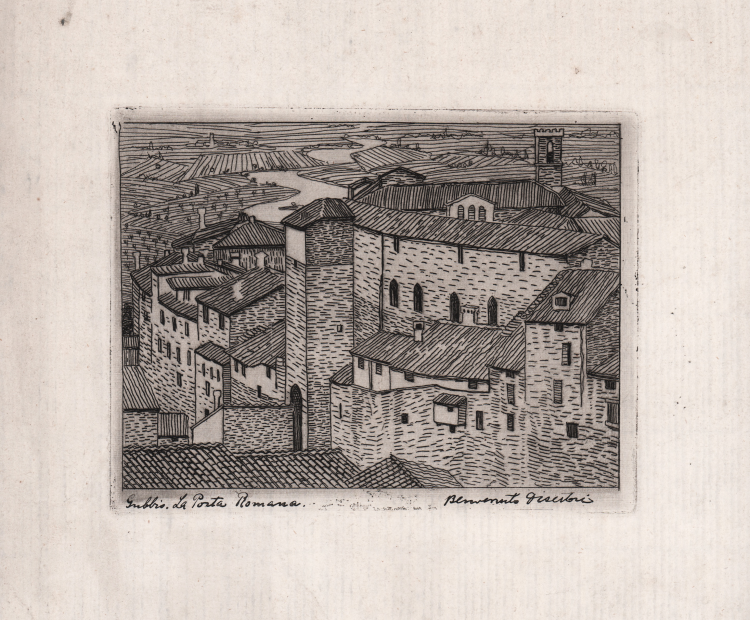



| Reference: | S42610 |
| Author | Benvenuto DISERTORI |
| Year: | 1912 ca. |
| Measures: | 175 x 130 mm |


| Reference: | S42610 |
| Author | Benvenuto DISERTORI |
| Year: | 1912 ca. |
| Measures: | 175 x 130 mm |
Etching, ca. 1912-13, titled and signed in pen at bottom: Gubbio. Gubbio. La Porta Romana (a sx.) Benvenuto Disertori (a dx.) Unique state.
“A preparatory drawing for this engraving (consisting only of the outlines of the essential elements of the composition) is preserved in Rovereto at the Mart print collection (2837), pencil on tracing paper. Compared to this drawing, the engraving is on the same verso. Another drawing, finished throughout, ink, is preserved in Milan, coll. A. Disertori. Compared to this drawing, the engraving is in the same verso. This second drawing is mentioned in the catalog of the 1912 exhibition at Palazzo Pesaro in Venice under the title Porta romana: Gubbio.
The etching depicts, in the same verso as the reality, a view of Gubbio from outside the walls. The point of view can be identified with the bell tower of the church of St. Augustine, whose construction began in 1251. The tower-like structure seen in the center, which in the engraving appears to be leaning against the series of buildings in the background, is the Porta Romana, now used as a museum. Prominent among the rooftops on the right are the hanging triple lancet window of the 14th-century Church of the Holy Trinity and the crenellated bell tower of the Gothic Church of St. Peter. The river flowing in the valley floor is to be considered an invention of the artist since the Camignano Stream, which in reality is of more modest size, runs away from Gubbio in another direction.
The realization of the work can be placed in the years 1912-1913, as it is conceivable that it occurred at a time not too distant from the execution of the preparatory drawing, documented in 1912.
The overall issue planned by Disertori for this plate was 50 examples. With certainty at least 14 were printed, as evidenced by the handwritten indication found on one of the examples preserved in Rovereto (2794). The engraving plate is preserved in Milan, at the coll. A. Disertori” (cfr. Benvenuto Disertori. Catalogo Ragionato dell'opera grafica e degli ex libris n. 8).
Mostly known as an engraver, Benvenuto Disertori (Trento, 16 February 1887 – Milan, 22 January 1969) also created beautiful woodcuts, etchings and drypoint and burin drawings. His works were showcased at Munich’s International Exhibition and Venice’s Biennale.
Furthermore, he combined his passion for art with great inclination for music: as a remarkable musicologist and musical paleographer, he studied and brought back to life unpublished and almost unknown sheets from the 1500s and 1600s. He deciphered and transcribed ancient music and collected a number of musical instruments, now kept at the Sforza Castle and at Milan’s Science and Technology Museum.
About Disertori, Carlo Tridenti – who for years was an art critic for “Giornale d’Italia”, Rome’s leading daily in the first half of the 20th century, wrote:
“He reveals a strong preference for old and solitary places, for the center of cities in Tuscany and Umbria where he carefully interprets the distinctive marks left by men and time, the houses and trees on the vanishing line towards the distant hills. It’s classic: shape is reduced to its primordial element, to lines, and clearly defined borders are the most fitting expressive means to convey the beauty of nature” (translated from “La Fiorentina Primaverile”, Florence 1922, pp. 86-87).
Bibliografia
Paolo Bellini; Alessia Alberti, Benvenuto Disertori. Catalogo Ragionato dell'opera grafica e degli ex libris, n. 8, p. 19, 2000; Pica 1920, n. 61; Calabi 1935, n. 16; Petrucci 1950, n. 12; Emert 1967, p. 31; Sonzogno 1969, n. 38; Bellini 1972, n. 29.
Benvenuto DISERTORI(Trento, 16 febbraio 1887 – Milano, 22 gennaio 1969)
Benvenuto DISERTORI(Trento, 16 febbraio 1887 – Milano, 22 gennaio 1969)